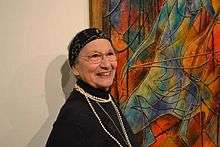Esther Geller
| Esther Geller | |
|---|---|
 | |
| Born |
October 26, 1921 Boston, Massachusetts, U.S. |
| Died |
October 22, 2015 (aged 93) Boston, Massachusetts, U.S. |
| Movement | Abstract Expressionism |
Esther Geller (October 26, 1921 – October 22, 2015) was an American painter mainly associated with the abstract expressionist movement in Boston in the 1940s and 1950s. She was one of the foremost authorities on encaustic painting techniques.[1][2]
Life and career
Geller studied at the School of the Museum of Fine Arts in Boston, and taught there with Karl Zerbe.[3] It was at the Museum School that she began painting with encaustic, a mixture of pigment and hot wax. She first received acclaim as a painter of "organic abstractions" in the 1940s when she exhibited with a group of other emerging artists later known as the Boston Expressionists.[4][5] Her work was more abstract than that of Zerbe and other Boston figurative expressionists.[6][7]
After marrying the composer Harold Shapero in 1945,[8][9] Geller continued painting and exhibiting, and taught art classes at the DeCordova Museum in Lincoln, Massachusetts. She was active as a painter for over seventy years.[10] As recently as 2012 her encaustics were shown in a major exhibit, The Future of the Past: Encaustic Art in the 21st Century, at the Mills Gallery in Boston.[11] The exhibit also included a video demonstration by Karl Zerbe and an interview with Geller.[12] Her works are included in the permanent collections of the Boston Museum of Fine Arts, the Addison Gallery of American Art,[13] the Danforth Museum,[1] and the DeCordova Museum.[14] On October 22, 2015, Geller died at the age of 93.[2]
Influence
Art historian Judith Bookbinder names Geller, along with David Aronson and others, as one of the emerging artists in the 1940s who influenced the direction of modern art in Boston.[4] In 2002, Geller's early work was included in The Visionary Decade: New Voices in Art in 1940s Boston at Boston University, a retrospective of the vibrant art scene in postwar Boston.[15] Jean Gibran, wife of the artist Kahlil Gibran, names Geller as one those "who have contributed in unique ways to the flowering of Boston Expressionism."[16]
Geller was a leading expert on encaustic painting who experimented with the medium and developed her own methods, which she used and taught for decades. An interview in which she discussed her methods was featured in Arts magazine in 1957,[17] and she has contributed to books on the subject.[18][19]
References
- 1 2 "Esther Geller, 93; artist known for her mastery of encaustic painting". The Boston Globe. November 9, 2015.
- 1 2 "Renowned Natick Artist Esther Geller Dies at 93". Patch Media. October 24, 2015. Retrieved 28 October 2015.
- ↑ University of Illinois, College of Fine and Applied Arts (1950). Contemporary American Painting and Sculpture. The University of Michigan. pp. 41, 175.
- 1 2 Bookbinder, Judith (2005). Boston Modern: Figurative Expressionism as Alternative Modernism. UPNE. p. 193. ISBN 9781584654889.
- ↑ "Youth on March in Art: Boston Group Exhibits Vigorous". The Boston Globe. 17 February 1946.
- ↑ McQuaid, Cate (18 September 2002). "Despite Gaps, Exhibit Shows Boston's Vigor in the '40s". The Boston Globe.
The final section of the show segues into abstraction. Esther Geller's encaustics meld the figure into a dancing abstract form...
- ↑ Driscoll, Edgar (16 November 1952). "New Gallery Opens Its Doors on Newbury St.". The Boston Globe. (Subscription required (help)).
- ↑ Brown, Nicholas. "Interview with Esther Geller". Library of Congress. An interview about Harold Shapero and Irving Fine.
- ↑ Driscoll (1952). Driscoll, covering both Geller's "one man show" at the Boris Mirski Gallery and another by Louis Kronberg, wrote, "Taking the lady before the gentleman (to prove that chivalry isn't dead, of course) one finds Miss Geller, in real life, the wife of Harold Shapero..." before going on to observe that her style had become more abstract in recent years and praising her "flair for rhythm, deftly handled patterning, and integrated composition".
- ↑ Temin, Christine (27 September 1995). "Nothing retiring about Hub's senior artists". The Boston Globe. (Subscription required (help)).
- ↑ McQuaid, Cate (13 November 2012). "Uncovering the many layers of wax-based painting". The Boston Globe. (Subscription required (help)).
- ↑ Gibran, Jean (2014). Love Made Visible: Scenes from a Mostly Happy Marriage. Interlink Publishing. p. 222. ISBN 9781623710521.
- ↑ Chaet, Bernard (1960). Artists at Work. University of California. p. 64.
- ↑ Moods and Moments: Boston - 1951. DeCordova and Dana Museum and Park. 1951.
- ↑ McQuaid (2002). "Back in the 1940s, Boston was a hotbed for modern art. The artists' community here drew attention from national magazines like Time, Life, and Art News...The Boris Mirski Gallery held exchange shows with New York's Downtown Gallery on 57th Street."
- ↑ Gibran (2014), p. 213.
- ↑ Chaet, Bernard (May 1957). "Studio Talk: An Interview with Esther Geller". Arts (31): 63.
In the course of her work she has developed a number of methods which should interest painters generally. Miss Geller employs a two-burner electric plate with rheostat heat control...
- ↑ Pratt, Frances; Fizell, Becca (1949). Encaustic: Materials and Methods. Lear.
- ↑ Chaet (1960), Chapter 10.
External links
- Paintings by Esther Geller
- Interview with Esther Geller (video)
- Portrait of Esther Geller by Barbara Swan
- Esther Geller in 1947 photo of eleven Massachusetts painters, National Portrait Gallery